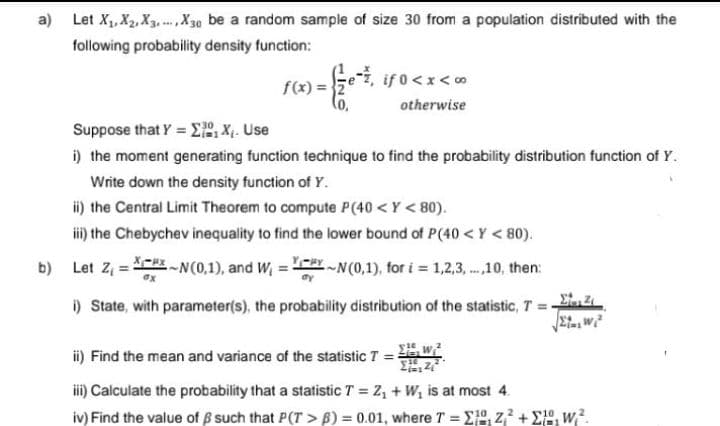a) Let X₁, X₂, X3, X30 be a random sample of size 30 from a population distributed with the following probability density function: f(x)=2 if 0
a) Let X₁, X₂, X3, X30 be a random sample of size 30 from a population distributed with the following probability density function: f(x)=2 if 0
A First Course in Probability (10th Edition)
10th Edition
ISBN:9780134753119
Author:Sheldon Ross
Publisher:Sheldon Ross
Chapter1: Combinatorial Analysis
Section: Chapter Questions
Problem 1.1P: a. How many different 7-place license plates are possible if the first 2 places are for letters and...
Related questions
Question

Transcribed Image Text:a) Let X₁, X₂, X3..., X30 be a random sample of size 30 from a population distributed with the
following probability density function:
f(x) =
if 0<x<∞
otherwise
Suppose that YΣX₁. Use
=
i) the moment generating function technique to find the probability distribution function of Y.
Write down the density function of Y.
ii) the Central Limit Theorem to compute P(40 <Y <80).
iii) the Chebychev inequality to find the lower bound of P(40<Y <80).
b)
Let Z₁-N (0,1), and W₁=~N(0,1), for i = 1,2,3,...,10, then:
=
dx
i) State, with parameter(s), the probability distribution of the statistic, T = 2
ii) Find the mean and variance of the statistic T =
16
iii) Calculate the probability that a statistic T = Z₁ + W₁ is at most 4.
iv) Find the value of such that P(T> B) = 0.01, where T = 1, Z²+1, W².
Expert Solution
This question has been solved!
Explore an expertly crafted, step-by-step solution for a thorough understanding of key concepts.
Step by step
Solved in 4 steps with 3 images

Recommended textbooks for you

A First Course in Probability (10th Edition)
Probability
ISBN:
9780134753119
Author:
Sheldon Ross
Publisher:
PEARSON


A First Course in Probability (10th Edition)
Probability
ISBN:
9780134753119
Author:
Sheldon Ross
Publisher:
PEARSON
